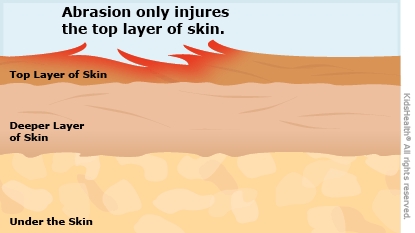Abrasion: How to Care for Your Child
An abrasion is a scrape of the top layer of skin. Most abrasions can be treated at home. They usually heal without leaving a scar.


-
Wash the abrasion with soap and water every day until healed. Don't use alcohol or hydrogen peroxide, as they can irritate the abrasion.
-
After washing, cover the abrasion with a nonstick bandage (such as BAND-AID®, CURAD® or a store brand). After a scab forms, you don't need to keep the abrasion covered.
-
Apply antibacterial ointment (names include triple antibiotic, bacitracin, Neosporin® or Polysporin®) if your health care provider recommended it.
-
If your child has pain and your health care provider says it's OK, you can give one of these medicines:
-
acetaminophen (such as Tylenol® or a store brand)OR
-
ibuprofen (such as Advil®, Motrin® or a store brand)

-
The area around the abrasion becomes more painful, red, or swollen.
-
The abrasion starts to drain yellow or green fluid.
-
Your child gets a fever.

How does an abrasion happen? Most abrasions in kids happen when they fall. An abrasion may also happen when someone rubs up against a rough surface.
What does an abrasion look like as it heals? At first, an abrasion can look wet or ooze a little clear fluid. As healing continues, the fluid dries and a scab forms. The scab slowly goes away.